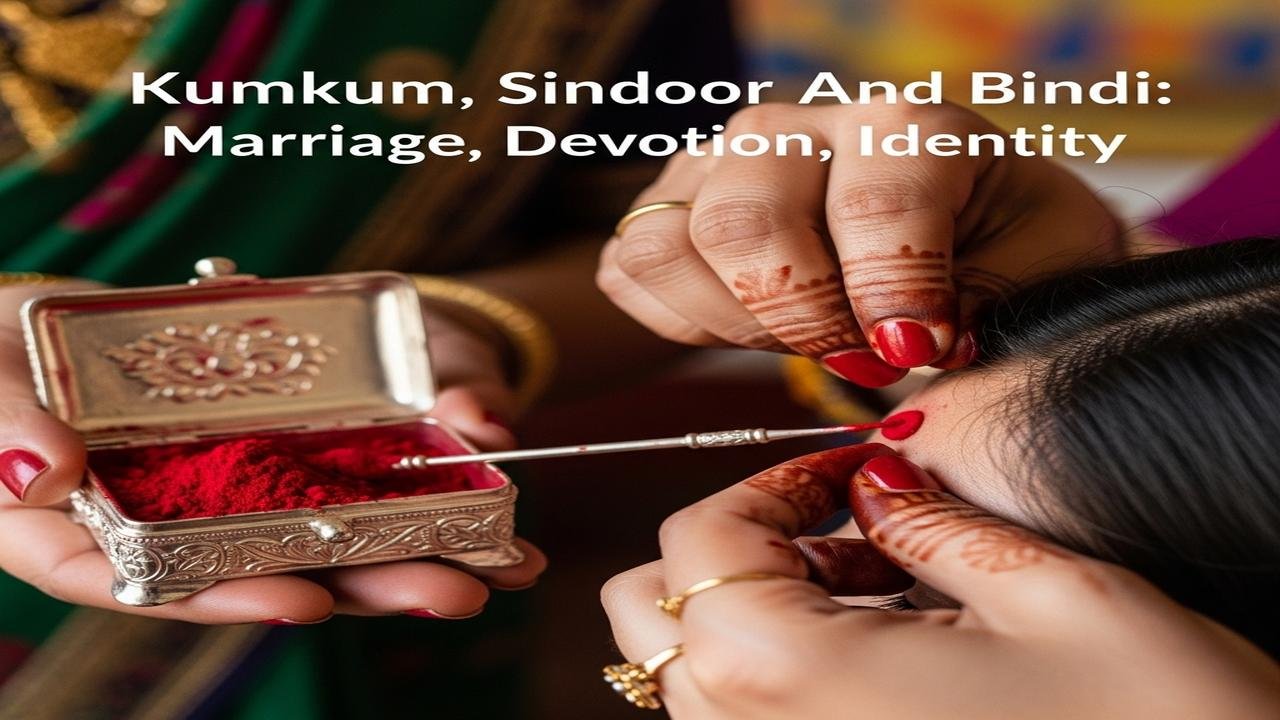Kumkum, Sindoor And Bindi: Marriage, Devotion, Identity

Introduction
The red powder many people call kumkum — commonly known outside scholarly contexts as vermilion or sindoor — is one of the most recognizable marks associated with Hindu women. Its presence on the forehead, on the hair parting or in the hairline often signals layered meanings: religious, social and personal. Below I unpack the main historical and living explanations offered across traditions, while noting regional variation and contemporary shifts.
What is “kumkum”?
Kumkum — vermilion powder — is traditionally a fine red pigment made from powdered red lead or turmeric treated with alkaline substances and, in many places today, commercially available synthetic pigments. Closely related terms appear in everyday use: sindoor often denotes the compound applied into the hair parting, while bindi refers to a decorative dot placed between the eyebrows. Usage and material differ by region and community.
Different forms and materials
- Bindi: a small dot on the forehead, sometimes a small sticker or ornament; worn by women and, in modern times, sometimes by men in ritual contexts.
- Sindoor: paste or powder placed along the hair parting (the maang) after marriage; often more long-lasting than a bindi.
- Regional substitutes: in some south Indian communities turmeric paste, sandalwood or kumkum mixed with oil are used, producing orange-red hues rather than pure vermilion red.
Religious and symbolic meanings
Meanings are multiple and sometimes overlapping; no single explanation covers every tradition. Below are the principal interpretive strands found in textual, ritual and popular practice.
- Marital status and social identity: In many communities the application of sindoor in the hair parting is a public signifier of marriage. During the wedding ritual (vivaha), there is often a distinct moment when the husband applies sindoor or places it as part of the bride’s ornaments. For many families this mark functions as an outward sign that a woman is wedded and thereby under certain social protections and responsibilities linked to family and household life.
- Auspiciousness and blessing: In Smarta and Vaishnava circles, red is associated with Lakshmi (prosperity) or general auspiciousness. Applying kumkum is therefore an invocation of good fortune and domestic well-being. Women often apply or receive kumkum in household puja or at festivals to mark auspicious beginnings.
- Divine feminine and Shakti: In Shaiva and Shakta sensibilities, kumkum is explicitly tied to Shakti — the goddess principle or creative energy. Red on the forehead or hairline can be read as devotional identification with the goddess, and in some Tantric and Shakta rites the mark is a sacramental sign of initiation or blessing.
- Third eye and psycho-spiritual symbolism: Popular and some contemporary spiritual interpretations associate the spot between the eyebrows (where a bindi is placed) with the ajna or “third eye” centre. This reading links the mark to attention, inward focus or spiritual sight. Scholars and practitioners note, however, that this is a later and partly modern gloss layered onto older social and ritual meanings.
Ritual moments and lifecycle uses
- Wedding rites: Sindoor application or the offering of kumkum is commonly part of the marriage ceremony; in many regions the groom or elders apply it to mark the bride’s new status.
- Daily puja and festivals: Women—married or unmarried—may offer kumkum to images of deities, to elders, or as part of festival observances such as Karva Chauth, Teej, or Durga Puja (in regionally specific ways).
- Widowhood and variation: Traditionally, many communities have discouraged widows from wearing kumkum, viewing it as a marital emblem. Practices now vary widely: in some communities widows no longer wear sindoor, while in others customs have relaxed or been reinterpreted.
Regional and community differences
India’s diversity means practice differs sharply by region, caste, and sect. Bengali married women participate in Sindoor Khela on Vijayadashami (the final day of Durga Puja), smearing sindoor on one another; in many Maharashtrian households the red dot may be replaced or complemented by a crescent-shaped tilak; in South India, kumkum with turmeric predominates. In some devotional communities the bindi is more a devotional mark than a marital one. Urban, diasporic and fashionable uses also reframe the sign as personal style rather than status marker.
Social, legal and modern meanings
Beyond ritual meaning, kumkum has social functions: it forms part of gendered dress codes, signals social belonging, and historically has been read as indicating marital protections. In recent decades feminist critiques and changing gender norms have prompted many women to rethink the sign—some retain it as religious devotion, some as cultural identity, and some reject it as patriarchal symbol. At the same time, many women of diverse marital statuses adopt the bindi as a non-marital ornament or statement.
Care, commerce and safety
Kumkum today is widely manufactured and sold; purity, ingredients and method of preparation vary. Some traditional formulations used heavy metals; many modern products are synthetic pigments made for durability. If you have sensitive skin or allergies, test a small area first and choose reputable products.
Conclusion
Kumkum and sindoor are rich cultural signs whose meanings change with context. For many they remain a sacramental mark of devotion and auspiciousness; for others a marker of marriage or household identity; and for still others a personal or fashionable choice. Across Śaiva, Vaiṣṇava, Śākta and Smārta traditions the mark is read differently—but the common thread is that a small red sign can encode theology, ritual belonging and everyday life in ways that are at once intimate and public.
